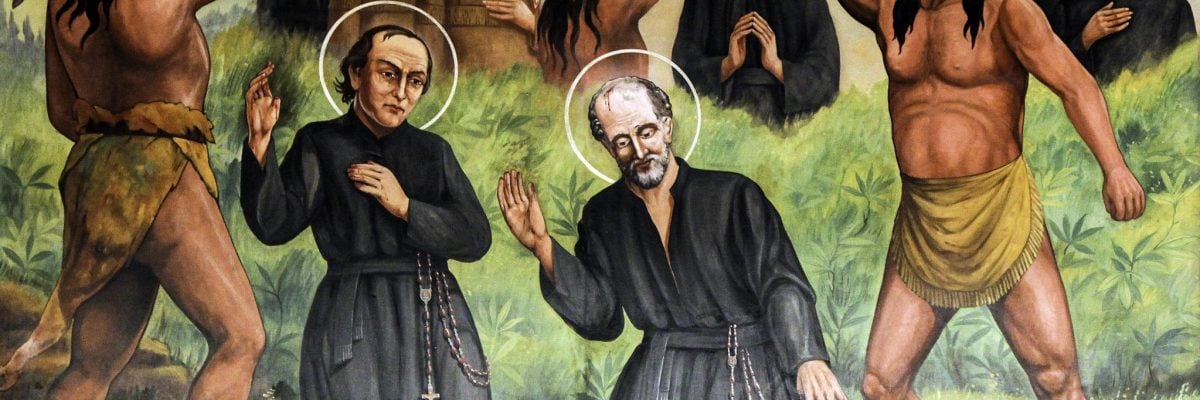
On Christmas Eve 1643, a merchant vessel left Cornwall southbound for Brittany, carrying cargo more precious than whatever filled its holds. Letting go anchor the next morning, the ship’s crew lowered a small rowboat, which left on the beach a man whose lined countenance suggested more than his thirty-six years. Making his way to a nearby fishing cottage, he found two men expecting perhaps a Catholic refugee of the English Civil War. They heard perfect French.
“Is there a church close where I can hear Mass?” begged the man.
“Yes—a monastery not far up the road. Mass begins soon. Come join us for breakfast after.”
The man raced up the road to the monastery, where with tears in his eyes he assisted at his first Mass in almost two years. Later he would write, “It was at this moment that I began to live once more. It was then that I tasted the sweetness of my deliverance.”
Later, devouring breakfast at the home of his hosts, the man could not conceal his deformed hands. What fingers he yet possessed were badly maimed. Some were mere stumps. Some had no fingernails. The thumb of his left hand was missing. The young daughters of the household gave him a few coins they had saved. A merchant from the village gave him a horse and pointed him 130 miles to Rennes, home of a college of the Society of Jesus.
Arriving on the eve of Epiphany, the man knocked on the door of the seminary asking for the rector.
“He is preparing to offer Mass.”
“Please tell him I have news from the Jesuit missions in New France.”
The rector came with all haste. “Do you know Fr. Isaac Jogues?” he asked. “He is a prisoner of the Iroquois. Is he dead? Is he alive?”
“I know him well. He is alive. I am he.”
Subsequently, Fr. Isaac Jogues, who had suffered capture, torture, privation, and every form of unspeakable humiliation for more than a year at the cruel hands of Mohawk savages, was for four months fêted by the royalty of France. Pope Urban VIII, who had who canonized Loyola and Xavier and patronized the Jesuit reductions in Latin America, joyfully granted Fr. Isaac a dispensation once again to offer Mass even though he lacked a canonical set of fingers and thumbs. Indignum esset Christi Martyrum Christi non bibere sanguinem, he wrote. “It would be shameful that a martyr of Christ not be allowed to drink the blood of Christ.”
Fr. Isaac was filled with joy to ascend again ad altare Dei, yet his heart’s prayer was to return to New France, to the native peoples of the St. Lawrence Valley for whom he desired more than anything to bring baptism and the salvation of Jesus Christ, knowing with near certainty that his return would bring to him a brutal martyrdom.
St. Isaac Jogues is one of the eight North American Martyrs, also called the Canadian Martyrs, canonized in 1930 by Pope Pius XI, whose heroic courage and sacrificial love we honor today. Their missionary work during the first half of the seventeenth century, especially among the Hurons, is an epic tale rich in opportunities for reflection.
When we are inconvenienced, for example, turning our imaginations to the daily lives of the Jesuit martyrs should prove a quick tonic. Knowing that to convert the Indians they had to live among them and live as they did, the Jesuits endured the smoke and the squalor of the Huron longhouses, with their lack of hygiene and rampant promiscuity. The missionaries paddled and portaged along with the natives, slept on the hard ground, endured the bitter Ontario cold, and subsisted on eels and corn paste.
The story should also refocus our appreciation of the sacrament of baptism. It would be seven years—after first learning their language and then catechizing the Hurons—before St. Jean de Brébeuf baptized a healthy adult native. In time, 7,000 Hurons had the doors of heaven opened to them through the waters of baptism—and good thing, for most of the Huron people were later massacred by the vicious Iroquois in their wars of expansion.
And vicious does not overstate it. In March of 1649, the Iroquois tribes—Mohawk and Seneca, especially—invaded the Huron lands with fury. Fr. Jean and his young colleague, Fr. Gabriel Lalemont, were taken prisoner and forced to watch as the Hurons they had come to love were slaughtered, their skulls split by Iroquois tomahawks. Those spared the tomahawk—women, children, sick, elderly—were burned to death in their longhouses.
Binding Brébeuf and Lalemont along with other Huron Christians, the Iroquois dragged them to the neighboring town of St. Ignace at the southeastern end of Lake Huron’s Georgian Bay. Stripped naked, the priests and their Huron sons in Christ were subjected to the gauntlet. With blood-curdling shrieks, the Iroquois beat the Christians with clubs before confining them to a cabin that Brébeuf himself had designed with the hopes that it would one day be a church. There the Huron Christians consoled one another while the priests gave absolution.
Then the torture continued. First, they broke Brébeuf’s fingers. They pulled out his fingernails and gnawed his fingertips. Next, they bound him to a post, which the saint kissed—the instrument of his martyrdom. They set burning sticks around his feet and ran torches up and down his body, between his legs, around his neck, and under his arms. The saint’s flesh began to blister, but he made no cry, so they slashed his flesh with knives.
To the Hurons enduring the same ordeal, Brébeuf called out, “My sons, my brothers, let us lift up our eyes to heaven in our affliction. Let us remember that God is the witness to our afflictions, and very soon he will be our exceedingly great reward. Let us die in our Faith. The glory that awaits us will never have an end.” As the Mohawks stabbed him with the heads of spears he repeated aloud: “Jesus have mercy on us.”
To silence the giant of a priest, the savages cut off his lower lip and thrust a hot poker down his throat. Then they brought out Lalemont, around whose naked waist they had fastened a girdle of pine bark. Tying him to a stake alongside Brébeuf the Mohawks set fire to the pine bark.
Around Brébeuf’s neck the Indians had fastened a necklace of hatchet heads heated red in the fire. If he leaned forward, they burned his back. If he leaned back, they scorched his chest. “Jesus have mercy on us!” was his only cry.
The Iroquois, in their diabolical frenzy, tied around him another girdle of pine bark and set it aflame. Traitorous Hurons poured boiling water over him in a mockery of baptism. They sliced strips of flesh from his legs and ate them as he watched. They cut off his nose, his upper lip, his tongue. They shoved a torch into his mouth and gouged out his eyes. Dragging him to a platform, they hacked off his feet, scalped him, tore open his chest, ripped out his heart and ate it. Then they drank his blood, hoping to acquire his courage. Finally, a blow from a tomahawk cut his face in two.
Fr. Lalemont they tortured similarly throughout the night, being certain to bring him only to the brink of death before giving him reprieve. The young priest whom his superior had doubted was physically fit for the rigors of the missions of New France endured sixteen hours of torture before the angel met him with the crown of martyrdom.
A final point of reflection: the Jesuits were the best and the brightest of their time. Their colleges provided the finest and broadest education in Europe. These men could have been bishops, university professors, seminary rectors. They could have been writing academic treatises or making scientific discoveries. There were no finer minds. We may find it odd that they left so much behind to endure the wilderness of New France, but there was a time when the world’s best and brightest were sent to do the world’s most important work: bring souls into the Catholic Church.
That human instinct, if you will, that the best and brightest take up the most important work, is still with us. It is what we regard as the most important work that has changed.
Image copyright Lawrence, O.P.: https://www.flickr.com/photos/paullew/22276307986/in/photostream/



